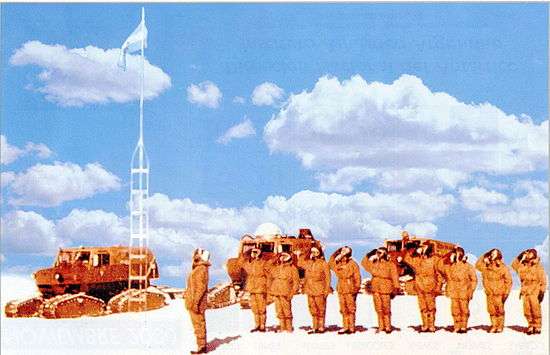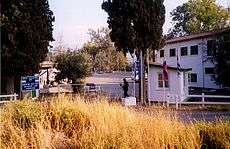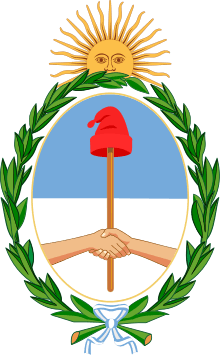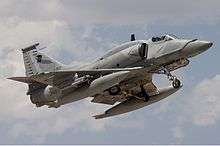Armed Forces of the Argentine Republic
| Armed Forces of the Argentine Republic Fuerzas Armadas de la República Argentina | |
|---|---|
|
Coat of arms of Argentina | |
| Current form | 9 September 1948[1] |
| Service branches |
Army Navy Air Force National Gendarmerie Naval Prefecture |
| Leadership | |
| Commander-in-Chief | President Mauricio Macri |
| Minister of Defense | Julio César Martinez |
| Chief of the EMC[2] | Major-General VGM[3] Bari del Valle Sosa[4] |
| Manpower | |
| Military age | 18 years old |
| Expenditures | |
| Percent of GDP | 0.8%[5] |
| Industry | |
| Domestic suppliers | Argentine defense industry |
| Foreign suppliers |
|
| Related articles | |
| History | Military history of Argentina |
| Ranks | Military ranks of Argentina |
The Armed Forces of the Argentine Republic, in Spanish: Fuerzas Armadas de la República Argentina, are controlled by the Commander-in-Chief (the President) and a civilian Minister of Defense. In addition to the Army, Navy and Air Force, there are two security forces, controlled by the Ministry of Security, which can be mobilized in occasion of an armed conflict: the National Gendarmerie, a gendarmerie used to guard borders and places of strategic importance; and the Naval Prefecture, a coast guard used to protect internal major rivers and maritime territory.
Traditionally, Argentina maintains close defense cooperation and military-supply relationships with the United States and Russia, and to a lesser extent, with Israel, Canada, Germany, France, Spain, Belarus, Turkmenistan, and Italy.
History
The Argentine military, as has been the tendency in other Latin American countries, were considerably more influential in former times. Starting in 1930 and throughout the 20th century, democratic governments were more often than not interrupted by military coups (see History of Argentina). The terrible consequences of the last dictatorship destroyed the military image as the moral reserve of the nation and opened the way to transform them to into today's armed forces.
1955–1963 internal strife
After the Revolución Libertadora coup that deposed president Juan Domingo Perón in 1955, the armed forces split into opposing sectors named Azules y colorados ("Blues and Reds"). The fight would end in 1963 with military clashes and the defeat of the reds who were opposed to Perón.
1965 Operacion 90

In 1965, the Argentine military conducted land military maneuvers on Antarctica under then-Colonel Jorge E. Leal. Nicknamed Operación 90, this was undertaken ten years before the Antarctic Treaty came into being and was conducted to cement Argentina's claims to a portion of those territories (still claimed as Argentine Antarctica).
1975 Counter-insurgency
In 1975 the armed forces started a massive operation in the Tucumán Province to crush the ERP (Ejército Revolucionario del Pueblo or People's Revolutionary Army) guevarist guerrilla group which attempted to create a "revolutionary foco in this remote and mountainous province, in the north-west of Argentina."
National Reorganization Process
The last military dictatorship, the National Reorganization Process, lasted from 1976 to 1983. As Isabel Perón was unable to defeat the terrorist organizations of Montoneros and ERP, the military took power during the 1976 Argentine coup d'état and exterminated the violent communist guerrillas by random detentions, torture or death. The current government of Cristina Fernández de Kirchner that sympathizes with Perón, antagonized the Armed Forces with the justification of the past junta and limits the powers of the current armed forced to avoid state terrorism of the past.
1978 Beagle Conflict
During much of the 19th and the 20th century, relations between neighbour Chile chilled due to disputes over Patagonia, though in recent years relations have improved dramatically.
1982 Falklands War

On 2 April 1982, the Military Junta invaded the Falkland Islands ( Spanish: Islas Malvinas ) sought to maintain power by diverting public attention from the nation's poor economic performance and exploiting the long-standing feelings of the Argentines towards the islands. Such action would also bolster its dwindling legitimacy. After short but fierce naval and air battles, the British landed on 21 May, and a land campaign followed until the Argentine forces surrendered on 14 June. 649 Argentines and 255 British died during the war.
The political effects of the war were strong and prompted even larger protests against the dictatorship, which hastened its downfall.
1983 transition to democracy
The democratic government of Raúl Alfonsín that took office in 1983 prosecuted the 1970s crimes and made the unprecedented (and only Latin American example) Trial of the Juntas and soon the Army was rocked by uprisings and internal infighting. Far-right sectors of the Army rebelled in the Carapintadas (painted faces) movement. To contain the rebellions, Alfonsín promoted the Full stop law and the Law of due obedience. The following president, Carlos Menem, gave the presidential pardon to the military found guilty in the Trial of the Juntas. It would not be until 1990, when the last military uprising in Argentine history was crushed, that the political conflict within the Army finally subsided.
In January 1989, during the subversive attack on La Tablada, the Army used white phosphorus in a violation of the Geneva Convention (according to a document presented by the human rights commission of the United Nations on January 12, 2001).[6]
Gulf War and 1990s
Argentina was the only Latin American country to participate in the 1991 Gulf War sending a destroyer and a corvette in first term and a supply ship and another corvette later to participate on the United Nations blockade and sea control effort of the gulf. The success of Operación Alfil ("English: Operation Bishop") as it was known, with more than 700 interceptions and 25,000 miles sailed on the operations theatre helped to overcome the so-called "Malvinas syndrome".
From 1990 to 1992, the Baradero-class patrol boats were deployed under UN mandate ONUCA to the Gulf of Fonseca in Central America. In 1994, the three Drummond-class corvettes participated on Operation Uphold Democracy in Haiti.
Also, in the 1990s, Argentine Armed Forces began a close defense cooperation and friendship policy with neighbors Brazil and Chile and focused in United Nations mandates.
The Argentine military have been reduced both in number and budget, but became more professional, especially after conscription was abolished by president Menem. The British embargo due to the Falklands War (Spanish: Guerra de las Malvinas) was officially eliminated and Argentina was granted a Major Non-NATO ally status by United States President Bill Clinton.[7]
Present
The modern Argentine Military Forces are fully committed to international peacekeeping under United Nations mandates, humanitarian aid on emergencies relief and support the country's continuous presence at Antarctica.
Democratic governments since 1983 straightened the military budget and did not approve any large scale equipment purchases. Argentina military spending is one of the lowest of South America[8][9] and as of 2010, its 0.9% of GDP only exceeds Suriname[10]
Since the 2000s, the Argentine defense industry was relaunched after the politics of privatization carried out during the 1990s by Carlos Menem administration virtually eliminated all.
While Mercosur is only an economic entity so far, the strengthening of confidence among the member countries has been beneficial to the peace in the region, exercising a useful role in supporting democracy. The Mercosur served, for example, to discourage the Paraguayan military from an attempted coup in early 2000.
In 2003, for the first time, the Argentine Navy (classified as major non-NATO ally) interoperated with a United States Navy battlegroup when destroyer ARA Sarandí (D-13) joined the USS Enterprise Carrier Strike Group and Destroyer Squadron 18 as a part of Exercise Solid Step during their tour in the Mediterranean Sea.
On June 12, 2006, President Néstor Kirchner brought into force the Defense Law, which had been passed in 1988 as a means to modernize the doctrine of the armed forces and define their role, though successive governments had failed to put it into effect. The law states that the armed forces will only be used against foreign aggression, and reduces the powers of the heads of the armed services, centralizing whole operational and acquisitions decisions under the authority of the Armed Forces Joint General Staff ( Spanish: 'Estado Mayor Conjunto de las Fuerzas Armadas' EMC ) emphasizing Jointness.
On 2007 an agreement for cooperation in peace operations was signed with France.[11]
Argentina created with Chile a combined force for future United Nations mandates.[12] Named Cruz del Sur (English: Southern Cross), the new force began assembly in 2008 with headquarters alternately on each country every year.[13]
On 2009, UNASUR, the South America countries union, created the CDS ( Spanish: Consejo de Defensa Sudamericano (South American Defence council) in order to promote cooperation and transparency between their armed forces[14]
On 2011 they perform with Chile the PARACACH ( Patrulla de Rescate Antártica Combinada Argentina-Chile, Argentine Chilean Antarctic combined search and rescue patrol ) with support of the German Space Agency which provided satellite imagery[15]
Structure
The three branches of the Argentine Military are under the direct authority of the Defense Ministry, while the Argentine National Gendarmerie and the Argentine Naval Prefecture, as security forces, under the direct authority of the Ministry of Security.
| Armed Forces (responsible to Defence Ministry) | ||||
|---|---|---|---|---|
| English | Spanish | Acronym | Description | Official website |
| Ministry of Defense | Ministerio de Defensa | MINDEF | Federal ministry | http://www.mindef.gov.ar/ |
| Argentine Army (includes Intelligence Service) | Ejército Argentino | EA | Army | http://www.ejercito.mil.ar/ |
| Navy of the Argentine Republic (includes Intelligence Service) | Armada de la República Argentina | ARA | Navy | http://www.ara.mil.ar/ |
| Argentine Air Force (includes Intelligence Service) | Fuerza Aérea Argentina | FAA | Air force | http://www.faa.mil.ar/ |
| Security Forces (responsible to Ministry of Security) | ||||
|---|---|---|---|---|
| English | Spanish | Acronym | Class | Official website |
| Ministry of Security | Ministerio de Seguridad | MINSEG | Federal ministry | http://www.minseg.gob.ar/ |
| Argentine National Gendarmerie (includes Scorpion Group) | Gendarmería Nacional Argentina | GNA | Gendarmerie | http://www.gendarmeria.gov.ar/ |
| Argentine Naval Prefecture (includes Albatros Group) | Prefectura Naval Argentina | PNA | Coast guard | http://www.prefecturanaval.gov.ar/ |
| Inter-service institutions | ||||
|---|---|---|---|---|
| English | Spanish | Acronym | Class | Official website |
| Armed Forces Joint General Staff (includes Intelligence Service) | Estado Mayor Conjunto de las Fuerzas Armadas | EMCFA | Joint high command | http://www.fuerzas-armadas.mil.ar/ |
| National Directorate of Strategic Military Intelligence | Dirección Nacional de Inteligencia Estratégica Militar | DNIEM | Intelligence support agency | http://www.mindef.gov.ar/ |
| National Geographic Institute | Instituto Geográfico Nacional | IGN | Geographic support agency | http://www.ign.gov.ar/ |
| Armed Forces Intelligence Institute | Instituto de Inteligencia de las Fuerzas Armadas | IIFA | Intelligence support agency | http://www.iifa.mil.ar/ |
| Armed Forces Scientific and Technical Research Centre (includes Information Security, Section 6) | Centro de Investigaciones Científicas y Técnicas de las Fuerzas Armadas | CITEFA | Research and development agency | http://www.citefa.gov.ar/ |
| Argentine Joint Training Centre for Peace Operations | Centro Argentino de Entrenamiento Conjunto para Operaciones de Paz | CAECOPAZ | Specialized training centre | http://www.fuerzas-armadas.mil.ar/caecopaz/index.htm |
International participation
Argentina was the only South American country to send warships and cargo planes in 1991 to the Gulf War under UN mandate and has remained involved in peacekeeping efforts in multiple locations like UNPROFOR in Croatia/Bosnia, Gulf of Fonseca, UNFICYP in Cyprus (where among Army and Marines troops the Air Force provided the UN Air contingent since 1994) and MINUSTAH in Haiti.
UNFICYP was also a precedent in the Latin American military as troops of Bolivia, Brazil, Chile, Paraguay, Peru and Uruguay are embedded in the Argentine contingent[16]
Since 1999 and as of June 2006, Argentina is the only Latin American country to maintain troops in Kosovo during SFOR (and later EUFOR) operations where combat engineers of the Argentine Armed Forces are embedded in an Italian brigade.
In 2007, an Argentine contingent including helicopters, boats and water purification plants was sent to help Bolivia against their worst floods in decades.[17] In 2010 the Armed Forces were also involved in Haiti and Chile humanitarian responses after their respective earthquakes.
Argentine military forces formed part of[18]
- Haiti - UN MINUSTAH video ( Including the Mobile Field Hospital and helicopters )
- Cyprus - UN UNFICYP ( including ARGAIR helicopters[19] )
- Serbia/Province Kosovo - NATO KFOR (CICKO) pictorial
- Serbia/Province Kosovo - UN UNMIK
- Belgium - NATO ICC-SHAPE
- Bosnia - NATO EUFOR
And as military observers in UNTSO, MINURSO, UNMIL, MONUC, UNMIS and ONUCI.
Argentina was also responsible for the White Helmets initiative.
Gallery
-

Independence Day Army parade, Junín, 2004
-

San Martin camp for UNFICYP in Cyprus
-
_and_an_Argentinean_P-3_aircraft_patrol_the_northern_approach_to_the_Panama_Canal.jpg)
P-3B on joint operations in Panama
-

Development: CH-14 Aguilucho
-

Argentine Antarctic presence
See also
- Argentine Army
- Argentine Naval Aviation
- Argentine Air Force
- Argentine Army Aviation
- List of active Argentine military aircraft
- Military ranks of Argentina
- Argentine defense industry
- Argentina and weapons of mass destruction
- Foreign relations of Argentina
References
- ↑ http://www.fuerzas-armadas.mil.ar/Resena-Historica.aspx
- ↑ Joint General Staff of Argentine Armed Forces
- ↑ Veteran of the Falklands War
- ↑ http://www.ambito.com/823637-macri-cambia-la-cupula-de-las-fuerzas-armadas
- ↑ http://www.lanacion.com.ar/1928453-el-papel-de-las-fuerzas-armadas
- ↑ E/CN.4/2001/NGO/98, United Nations, January 12, 2001 - URL accessed on February 9, 2007 (Spanish); ANSA cable quoted by the RaiNews24: See frame on the right (Italian). See also presentation of the attack here (Spanish), La Historia Pensada (Spanish), Los puntos oscuros del asalto a La Tablada, Página/12, January 23, 1999 (Spanish)
- ↑ ... represents our recognition of the importance of Argentina's leadership and cooperation in the field of international peacekeeping, notably during Operation Desert Shield/Desert Storm, in Haiti, in its role in supervising the peace between Peru and Ecuador, and in nearly a dozen other international peacekeeping efforts ...
- ↑ El presupuesto militar argentino, uno de los más bajos de la región
- ↑ Argentina sólo gasta 80 millones de dólares anuales en armamento.
- ↑ El presupuesto para Defensa es el más bajo de la historia
- ↑ Argentina y Francia suscribieron en diciembre de 2007 un acuerdo de cooperación en materia de operaciones de paz.
- ↑ Avance para la fuerza combinada con Chile
- ↑ Destinan $30 millones para operar con Chile
- ↑ CDS official site )
- ↑ Entrenamiento PARACACH
- ↑ Argentine Army: UNFICYP Archived April 23, 2007, at the Wayback Machine.
UN: Cyprus - UNFICYP - Facts and Figures Archived September 7, 2009, at the Wayback Machine.
Chilean Army: Misión de la ONU en Chipre desde el año 2003 Archived June 12, 2007, at the Wayback Machine.
Brasilian Army: UNFICYP Archived February 18, 2007, at the Wayback Machine. - ↑ Trabajo Conjunto en Bolivia
- ↑ "Jefatura de Gabinete de Ministros - Mapa de Sitio" (PDF). Jgm.gov.ar. Retrieved 2013-09-04.
- ↑ ARGAIR Archived August 5, 2010, at the Wayback Machine.
Sources
 This article incorporates public domain material from the CIA World Factbook document "2006 edition".
This article incorporates public domain material from the CIA World Factbook document "2006 edition". This article incorporates public domain material from the United States Department of State website http://www.state.gov/r/pa/ei/bgn/index.htm (Background Notes).
This article incorporates public domain material from the United States Department of State website http://www.state.gov/r/pa/ei/bgn/index.htm (Background Notes).
Further reading
- Osacar, Ignacio J. (18 May 2007). "Medio siglo de gastos para la Defensa y la Seguridad (1950-1965) - 1ra parte". NuevaMayoria.com (in Spanish). Buenos Aires, Argentina: Centro de Estudios Nueva Mayoría. Retrieved 2 January 2015.
- Osacar, Ignacio J. (5 June 2007). "Medio siglo de gastos para la Defensa y la Seguridad en Argentina (1976-2006)- 2da. Parte". NuevaMayoria.com (in Spanish). Buenos Aires, Argentina: Centro de Estudios Nueva Mayoría. Retrieved 2 January 2015.
External links
- Ministry of Defense (Spanish)
- Joint chiefs off Staff (Spanish)




